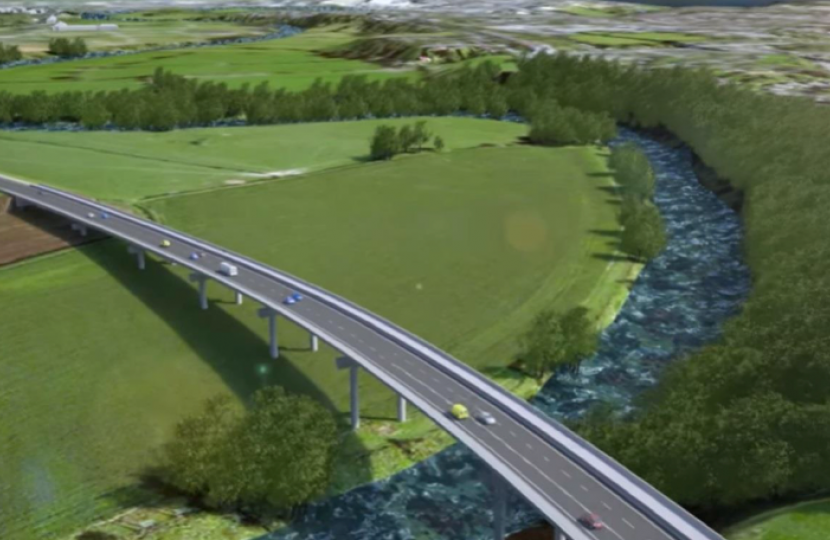
The proposed Shrewsbury North West Relief Road (NWRR) planning application should now go before the planning committee by the summer of 2022. A number of amendments have been made to the original scheme following consultations.
The primary aim of the Shrewsbury North West Relief Road is:
To improve Shrewsbury as a place in which to live, work and invest, by reducing congestion.
The main problem is the poor connectivity between the north and west of Shrewsbury for all modes of transport this has the following knock-on effects:
- Traffic congestion in Shrewsbury Town Centre
- Traffic congestion on the northern and western approaches to the town
- Traffic congestion on Shrewsbury’s outer bypass and distributor ring roads
- Unreliable journey times and long delays
- “Rat-running” traffic on unsuitable rural roads
- Inefficiency of the transport network, especially for buses
- Lack of network resilience
- Road accidents
- Poor air quality
- Carbon and other greenhouse gas emissions
AND:
Shrewsbury continues to grow. Developments are already under way at many points around the town. If nothing is done, all of the above problems will worsen. Traffic congestion is likely to get worse and journey times will become longer and less predictable as the network becomes less resilient, affecting both public and private transport. Rat-running could increase, as could accidents.
The north-west corridor is heavily used by buses in Shrewsbury. Most bus services from north Shrewsbury are concentrated on the A5112 Whitchurch Road approach which is heavily congested at peak times. The town bus station is located at the north-east end of Smithfield Road, near to the railway station, and as a result Smithfield Road carries more buses than any other road in Shrewsbury – between 30 and 35 local buses per hour.
Buses have to share local roads with general traffic, so when there is congestion, bus services are also delayed. This makes services less efficient and less reliable, whilst also being more expensive to operate, reducing the attractiveness of this more sustainable mode of transport.
The two new road schemes which have been put together to complete a ring road around the town are the Oxon Relief Road and the NWRR.
- The BENEFITS
To a large extent the benefits are a direct antithesis of the problems, namely improve connectivity and accessibility between the north and west of Shrewsbury for all modes of transport but specifically to:
- Reduce traffic congestion
- Improve the reliability of journey times and reduce unforeseen delays
- Reduce the amount of traffic rat-running on unsuitable rural roads
- Improve the efficiency of Shrewsbury’s transport network for all modes of transport.
- Improve the resilience of Shrewsbury’s transport network.
- Enhance the benefits of the Oxon Link Road and Integrated Transport Plan schemes.
- Reduce the number of people killed or seriously injured on roads in Shrewsbury.
- Improve air quality, especially in the built-up areas of Shrewsbury
- Reduce net emissions of CO2 and other greenhouse gases.
The Benefit Cost Ratio (BCR) of this project is 5.33 and demonstrates that the scheme offers VERY HIGH value for money.
The end result is designed to reduce traffic within the loop of the river by over 30%. Traffic along The Mount and Smithfield Road in particular, will be considerably eased and make it easier to introduce improved cycle and pedestrian facilities within the town centre.
- The FINANCING
There have been suggestions that funding for the North West Relief Road does not fully exist and is over budget. The following may assist in explaining how the project will be funded. The total cost of the combined scheme (Oxon & NWRR) is expected to be around £90million which includes some contingency finance for unexpected needs which may crop up. This is being financed by:
- A Central Govt grant of £54million - money that can only be used to build the NWRR or it will have to be repaid.
- The scheme for the Oxon Relief Road is being financed by way of grant funding from The Marches Local Enterprise Partnership (LEP) £12m
- Community Infrastructure Levy (CIL) Up to £16m
- Section 106 monies from housing development in the Oxon area approx. £8m
Note: The scheme also releases around 100 acres of development land that is owned by Shropshire Council and was originally part of the smallholdings estate. This is prime development land that is already included in the Shropshire Local Plan and could be a mix of employment and housing land. Land such as this is usually sold for between £300,000 and £500,000 per acre and is therefore valued at well over £30 million in total.
For more details relating to the application please follow the link:
https://newsroom.shropshire.gov.uk/2021/02/planning-application-shrewsb…




